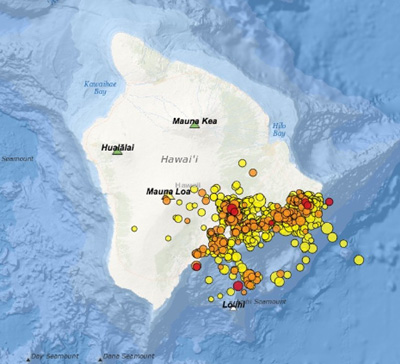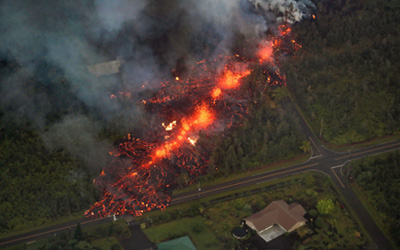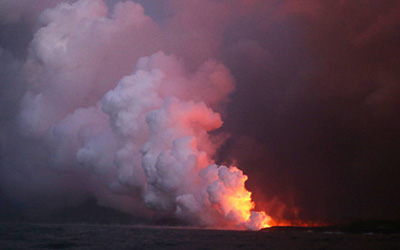According to a White House Statement, on May 8 President Donald Trump declared Kilauea volcano explosion a major disaster, ordering federal assistance to “supplement state and local recovery efforts in the areas affected by the severe storms, flooding, landslides, and mudslides”. On the other hand, the Hawaii Country Civil Defense delivered a red alert for air quality, warning the civilians to stay away from the gas since it can cause “choking and inability to breathe”.

In May 6, the Hawaiian Volcanoes Observatory confirmed that eight lava fissures had opened under Leilani Estates during the week from May 1 to May 6. In addition, they stated that the opening of the fissures mixed with the lava flow from Kilauea Volcano generated a series of earthquakes, including the one that took place in May 4 with a magnitude-6.9. On the other hand, Hawaii Country Civil Defense Agency confirmed on Thursday 17th evening: “The Hawaiian Volcano Observatory (HVO) has reported a new fissure down rift of Makamae Street in Leilani Estates… Several fissures have reactivated. HVO reports lava and flows have been generated”.
The fissures are forming lengthways of a northeast-southwest line that go through the whole island and fortunately, not all of the older fissures are actively emitting lava, Wendy Stovall – a volcanologist with the United States Geological Survey (USGS) stated. As well, local authorities said that active fissures are very dangerous not only due to the lava they produce, but because they have been emitting dangerous sulfur dioxide gases which are capable of killing. The figure above shows the areas covered by lava and the yellow points represent where fissures have opened up.


People in Hawaii are worried and declared a red alert because, as the HVO stated, “At any time, activity may become more explosive, increasing the intensity of ash production and producing ballistic projectiles near the vent”. Besides, the volcanic gas now released has destroyed 37 homes and generated the evacuation of approximately 2000 habitants.
In the third week of May the situation has turned critical because the lava coming from the volcano has reached the ocean, and the chemical reaction between these two components has created a cloud composed by steam, hydrochloric acid and fine glass particles that can be harmful to the eyes and skin and can generate breathing problems. Besides, scientist confirmed that it is not certain how long the eruption will last.
What is a fissure?
As Owen Gough – a reporter from the newspaper Daily Express – “a fissure – or a rift – is a long gap or crack in the ground created during an earthquake. They usually form because of a landslide or ground slump connected to the rapid withdrawal of groundwater during earthquakes. James Pechman, a University of Utah seismologist, told RCScience: "Most such cracks are on unconsolidated ground (as opposed to bedrock). They can develop from shaking, settling, and 'lurching' off the ground during an earthquake..." Typically, fissures take a considerable time to form and are relatively short, mostly no more than a few feet deep” (Gough, 2018). As said this fissures can be pretty dangerous due to the lava and sulfur dioxide gases they produce.
What is the relationship between fissures and earthquakes?
According to Tina Neal – the scientist in charge of the USGS Hawaiian Volcano Observatory – “the earthquakes occur as a result of magma moving along these rift zones, stressing the volcano”. As the fissures are releasing steam and gases – like sulfur dioxide – and the fact that Neal states that these releases are precursors to magma making its way to the surface, volcanologist are developing studies to determine whether the appearance of new fissures could led to a new lava field.
When earthquakes stop happening, it does not imply that the volcanic activity is arriving to its end thus, once the path is established, the amount of earthquakes decrease. As Brian Shiro affirmed: “The first lavas that were erupted during this sequence were all of a chemical composition assumed to be left over from the 1955 eruption. That magma had been stored underground since 1955, and during that time had been aging, degassing and crystallizing. The result is that it makes it stickier, more viscous, harder to move, and resistant to flow. For all those reasons, it took a lot of work to squeeze that magma out; translates in many earthquakes. Not only the path is already open but the lava is also more fluid, there is no need to make earthquakes”.

It is possible to pinpoint the location where fissures will open?
As Brian Shiro – a USGS scientist whose expertise is in seismology – said in an interview “the magma moves around underground and it breaks rocks in the process. Breaking rocks sends vibrations through the ground as earthquakes that we can measure. If we pay close attention to the pattern of the earthquakes in space and time, we can track the movement of magma beneath the surface. We look for earthquake epicenters marching laterally to indicate magma propagation, and if they start getting shallower towards the surface, that might indicate where an eruption could happen”.
Scientists are able to locate the likely spots where fissures will open, and determine which residents need to evacuate first. For this to happen, all earthquakes propagating down a rift in advance of magma must be track, whilst ground crews look for signs of impeding eruptions including the opening of ground cracks which produce steam when magma heats water in them, and eventually produce lava at the surface.
Bibliografía
Ducharme, J., Langone, A., Quackenbush, C., & Segarra, L. M. (13 de Mayo de 2018). Hawaii Volcano at Risk of Explosive Eruptions That Could Eject "Balistic Projectiles": The Latest on the Kilauea Volcano. Time.
Jones, C., & Mcavoy, A. (21 de Mayo de 2018). Lava From Hawaii's Kilauea Volcano Has Reached the Pacific Ocean and It's Creating a New Danger. Time.
Quackenbush, C. (18 de Mayo de 2018). Hawaii on "Red Alert"After Huge Ash Cloud Bursts From Kilauea Volcano. Time.
▪ ▪ ▪
Related content
Kīlauea Volcano Erupts - usgs.goIf you would like a comprehensive web resource for all-things-Kilauea, please go to the "Resources for 2018 Kīlauea Lower East Rift Zone and Summit Activity" webpage for a variety related links. |


